State and local governments collected a combined $4.1 trillion of general revenues in fiscal year 2021, from a mix of income taxes, sales taxes, property taxes, charges for specific government services, and other sources.
State and local governments collected $4.1 trillion of general revenues in 2021.
That amount includes intergovernmental transfers from the federal government. And it excludes revenues from government's "business-like" activities such as water, gas, electricity, and transit utilities; government-run liquor stores; and government-administered insurance trusts such as employee retirement, unemployment compensation, and workers’ compensation systems.
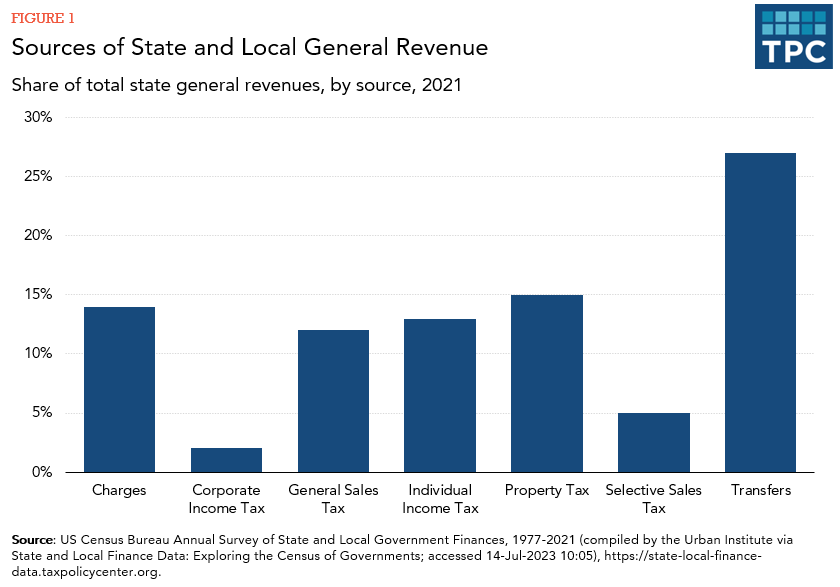
Taxes provided 52 percent of state and local general revenues in 2021, including:
- 15 percent from property taxes
- 13 percent from individual income taxes
- 12 percent from general sales taxes and gross receipts taxes
- 5 percent from selective sales taxes on purchases such as alcohol, motor fuel, and tobacco products
- 2 percent from corporate income taxes
- 3 percent from all other taxes such as license taxes, estate taxes, and severance taxes
Charges, such as payments to a public hospital, tuition paid to a state university, and sewerage fees, when combined, provided another 14 percent of state and local general revenues in 2021.
What are the sources of revenue for state governments?
State governments collected $2.7 trillion of general revenues in 2021.
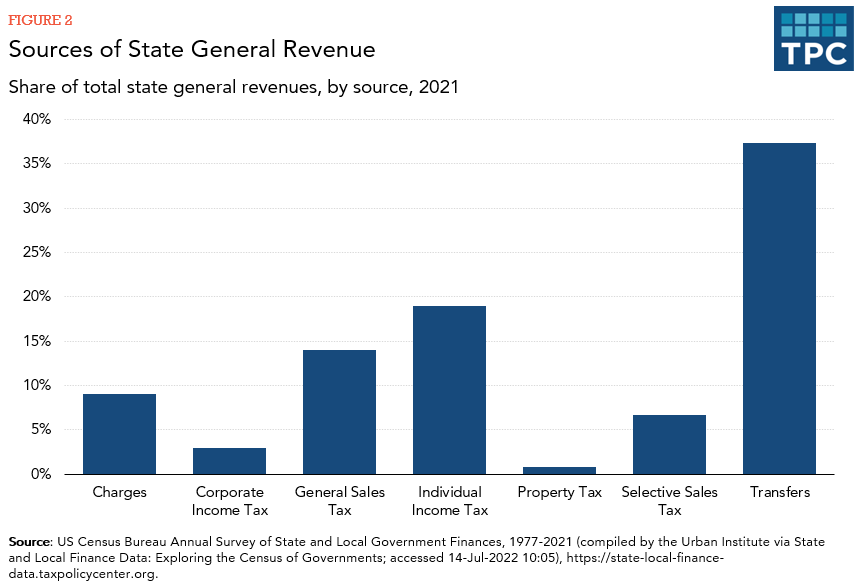
Taxes provided 47 percent of state general revenues in 2021, including:
- 19 percent from individual income taxes
- 14 percent from general sales taxes and gross receipts taxes
- 7 percent from selective sales taxes on purchases such as alcohol, motor fuel, and tobacco products
- 3 percent from corporate income taxes
- 4 percent from other taxes such as estate taxes, property taxes, and severance taxes
Charges, such as tuition paid to a state university, payments to a public hospital, and tolls on highways, when combined, provided another 9 percent of state general revenues in 2021. Miscellaneous sources, such as special assessments, provided 7 percent of state general revenue.
Taxes, fees, and user charges are considered "own-source" revenue.
The final 37 percent of state general revenue came from intergovernmental transfers. In 2021, 37 percent of state general revenue came from the federal government (e.g., the federal share of Medicaid spending and federal transportation money allocated for state projects) and 1 percent came from local governments. (Sources of state general revenue do not sum to 100 percent because of rounding.)
Intergovernmental transfers were relatively high in 2021 because of federal spending in response to the COVID-19 pandemic. In 2019, federal transfers were 32 percent of state general revenue. In 2020 and 2021, Congress transferred a large amount of funds to state governments as part of the CARES Act, the Coronavirus Response and Relief Supplemental Appropriations Act (part of the December 2020 omnibus bill), and the American Rescue Plan. As such, federal transfers should remain a relatively large share of state general revenue for the next few years.
What are the sources of revenue for local governments?
Local governments collected $2.0 trillion in general revenues in 2021.
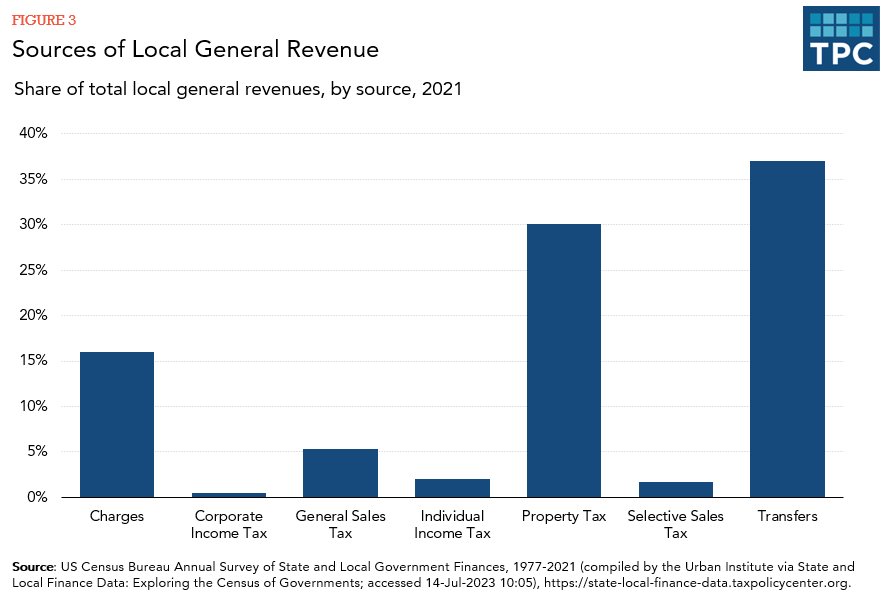
Taxes provided 42 percent of local general revenues, including:
- 30 percent from property taxes
- 5 percent from general sales taxes and gross receipts taxes
- 2 percent from selective sales taxes on purchases such as alcohol, motor fuel, and tobacco products
- 2 percent from individual income taxes
- 3 percent from other taxes such as a locality's taxes on hotel bookings and restaurant meals
Charges, such as city revenue from sewerage and parking fees, when combined, provided 16 percent of local general revenues in 2021. Another 5 percent of local general revenue came from miscellaneous sources such as amounts received from the sale of property and interest from some investment securities.
The final 37 percent of local government general revenue came from intergovernmental transfers. In 2021, 7 percent of local government general revenue came directly from the federal government (e.g., federal funds for local transportation projects) and 31 percent came from state governments (the numbers do not sum to the total share from intergovernmental transfers because of rounding). However, the state government transfer total includes indirect federal funds that are initially allocated to states. For example, the federal government sends K-12 education funds to state governments that then distribute the money to local governments. (All sources of local government general revenue do not sum to 100 percent because of rounding.)
How have the sources of revenue for state and local governments changed over time?
In 2021 inflation adjusted-dollars, combined state and local general revenue increased from $1.3 trillion in 1977 to $4.1 trillion in 2021, or a 220 percent increase. As a share of the nation’s total GDP, state and local revenues comprised 17.3 percent in 2021, and have averaged 15 percent since 1977.
All major sources of revenue have grown in real dollars since 1977, with individual income tax seeing the largest increase in percentage terms (from $131 billion in 1977 to $545 billion in 2021, or a 317 percent increase) and transfers seeing the largest increase in total dollars (from $279 billion in 1977 to $1.1 trillion in 2021, or a 301 percent increase).
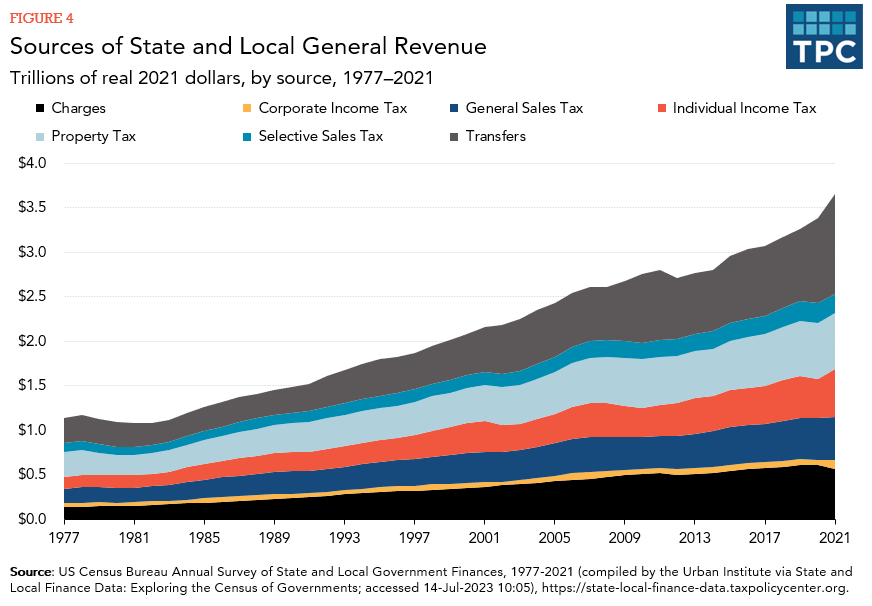
In 2021, transfers from the federal government provided 27 percent of combined state and local general revenues. The largest state and local general own-source funds came from property taxes (15 percent) and charges (14 percent), followed by individual income taxes (13 percent), general sales taxes (12 percent), and selective sales taxes (5 percent).
Since 1977, property taxes as a share of combined state and local general revenues have declined while charges have increased. The share coming from property taxes fell from 22 percent of general revenue in 1977 to 17 percent in 1985, but since then property taxes as a share of general revenue have been relatively stable. In contrast, revenues from charges steadily increased from 11 percent of general revenue in 1977 to 16 percent in 2020; though, due to the COVID-19 pandemic, charges declined to 14 percent in 2021. Meanwhile, individual income taxes have also increased as a percentage of state and local general revenue, providing 10 percent in 1977 and 13 percent in 2021.
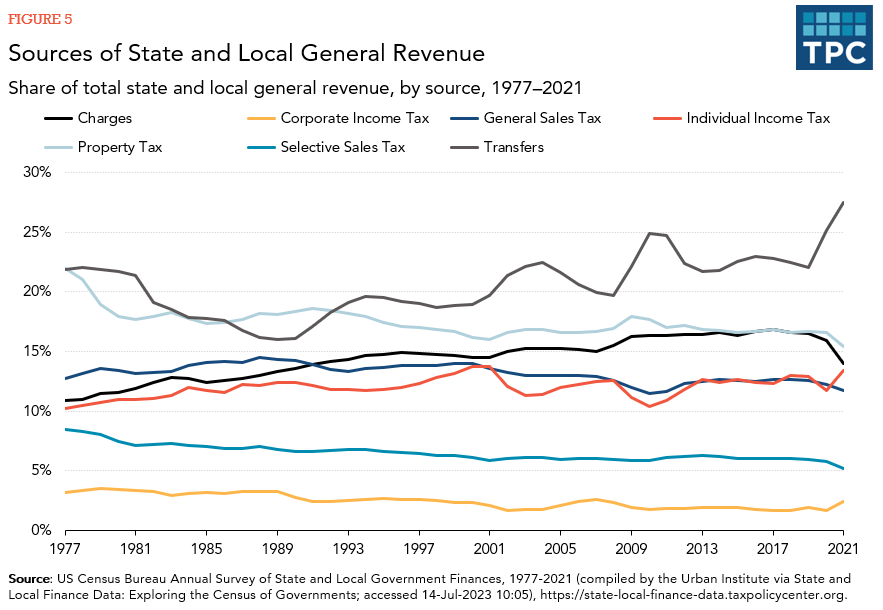
Transfers from the federal government have fluctuated considerably over the past three decades. They provided 22 percent of state and local general revenues in 1977, dropped to a low of 16 percent in 1989, and returned to 22 percent in 2003. The American Recovery and Reinvestment Act of 2009 created a sharp uptick in transfers from the federal government between 2009 and 2011, peaking at 25 percent of state and local revenues in 2010 and 2011, before falling back to 22 percent in 2012. As a result of the pandemic and the congressional response to it, federal transfers increased from 22 percent in 2019 to 25 percent in 2020 and 27 percent in 2021.
Updated January 2024
Dadayan, Lucy. 2023. State Tax and Economic Review. Washington, DC: Urban-Brookings Tax Policy Center. (Reports are updated quarterly.)
Dadayan, Lucy, and Kim Rueben. 2021. “Surveying State Leaders on the State of State Taxes.” Washington, DC: Urban-Brookings Tax Policy Center.
Boddupalli, Aravind, Tracy Gordon, and Lourdes German. 2021. “More Than Fines and Fees: Incorporating Equity into City Revenue Strategies.” Washington, DC: Urban-Brookings Tax Policy Center.
Boddupalli, Aravind, and Kim Rueben. 2021. “State and Local Government Revenues and Racial Disparities.” Washington, DC: Urban-Brookings Tax Policy Center.
Gordon, Tracy, Richard C. Auxier, and John Iselin. 2016. “Assessing Fiscal Capacities of States: A Representative Revenue System–Representative Expenditure System Approach, Fiscal Year 2012.” Washington, DC: Urban-Brookings Tax Policy Center.
Francis, Norton, and Frank Sammartino. 2015. “Governing with Tight Budgets; Long Term Trends in State Finances.” Washington, DC: Urban-Brookings Tax Policy Center.
Interactive Data Tools
State and Local Finance Data: Exploring the Census of Governments